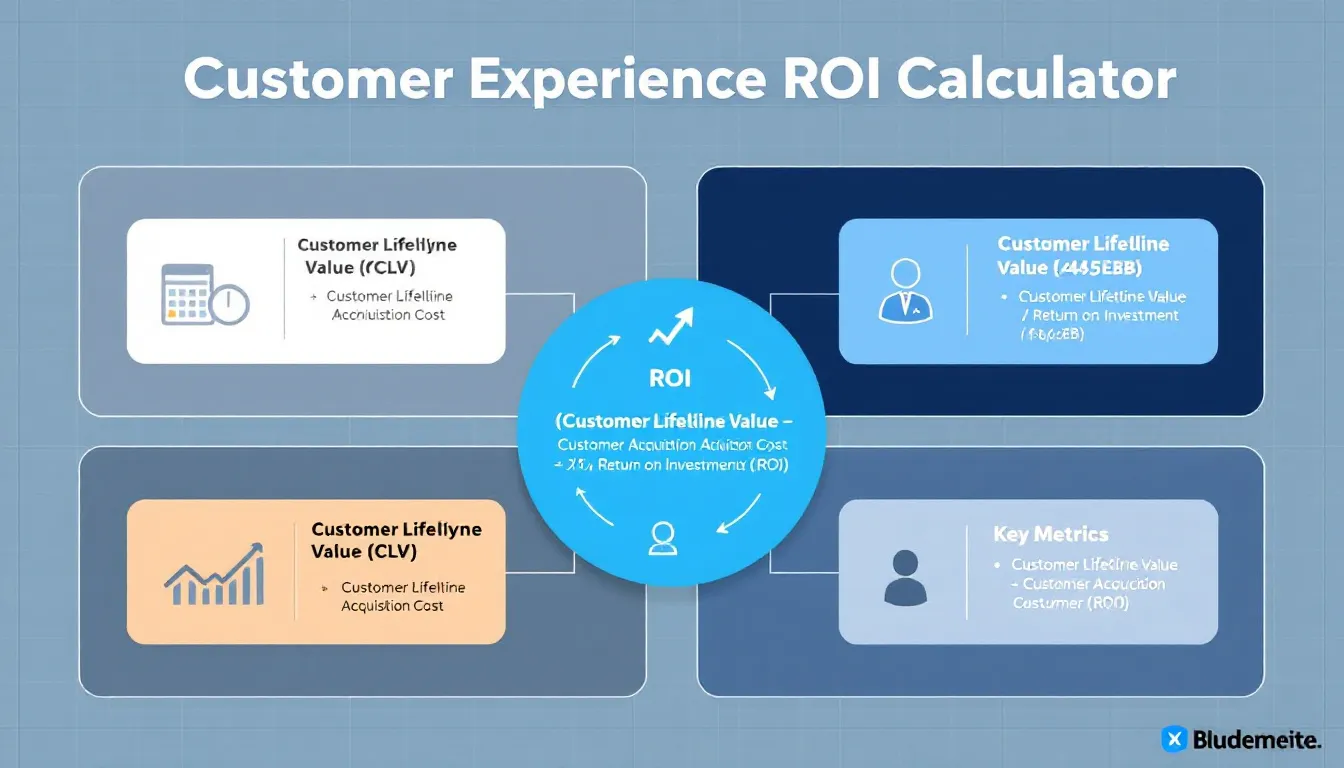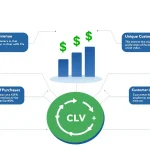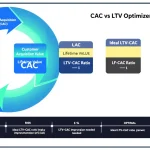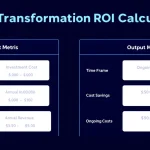CX ROI Calculator
Is this tool helpful?
How to Use the Customer Experience ROI Calculator Effectively
Use this customer experience ROI calculator to accurately estimate the financial impact of your CX initiatives. Follow these steps and input realistic values to see actionable results:
- Number of Customers: Enter the total customers you serve. For example, 4,200 for a growing retail chain or 12,000 for a subscription service.
- Average Annual Revenue per Customer ($): Input your typical yearly revenue per customer. Examples: $6,500 for a specialty product or $18,000 for enterprise software clients.
- Average Customer Lifespan (Years): Enter the average length of your customer relationship. Common values range between 2 and 8 years.
- Current Customer Retention Rate (%): Input your current retention percentage, such as 65% or 85%, reflecting how many customers stay annually.
- Expected Increase in Retention Rate (%): Estimate the retention gain after CX improvements, like 4% or 7%, based on your initiatives.
- Cost of CX Initiatives ($): Enter the total investment toward your CX programs—this might be $30,000 for a new CRM or $75,000 for training and process changes.
- Estimated New Customers: Project new customers attracted by positive word-of-mouth or improved CX, such as 250 or 600.
Understanding the Customer Experience ROI Calculator
This calculator helps you quantify the financial return from your customer experience efforts by linking customer retention, acquisition, and spending behavior. It streamlines complex calculations into clear financial insights you can use to guide your business decisions.
Key Benefits
- Identify the potential revenue uplift from better customer retention.
- Estimate additional income from new customers driven by improved CX.
- Calculate the overall net gain after subtracting CX investment costs.
- Determine return on investment (ROI) as a percentage to evaluate project success.
- Assess the payback period to understand how long before your investment recoups.
Mathematical Foundations of the Calculator
The calculator uses these formulas for precise financial projections:
Customer Lifetime Value (CLV):
$$ CLV = Average\ Annual\ Revenue\ \times\ Average\ Customer\ Lifespan $$Increase in Revenue from Retention:
$$ Increased\ Revenue = CLV \times Increase\ in\ Retention\ Rate\ (\%) \times Number\ of\ Customers $$Total Net Gain:
$$ Net\ Gain = Increased\ Revenue + (CLV \times New\ Customers) – CX\ Investment\ Cost $$Return on Investment (ROI):
$$ ROI\ (\%) = \frac{Net\ Gain}{CX\ Investment\ Cost} \times 100 $$Payback Period (in years):
$$ Payback\ Period = \frac{CX\ Investment\ Cost}{Annual\ Net\ Gain} $$Example Calculation Using the ROI Calculator
Imagine a SaaS company with these inputs:
- Number of Customers: 5,000
- Average Annual Revenue per Customer: $3,600
- Average Customer Lifespan: 3.5 years
- Current Retention Rate: 72%
- Expected Retention Increase: 6%
- Cost of CX Initiatives: $100,000
- Estimated New Customers: 300
Based on these values, the calculator would show:
- Customer Lifetime Value (CLV): $12,600 per customer
- Increased Revenue from Retention: $3,780,000
- Revenue from New Customers: $3,780,000
- Total Net Gain: $7,460,000 – $100,000 = $7,360,000
- Return on Investment (ROI): 7,360%
- Payback Period: Approximately 0.05 years (less than 1 month)
Benefits of Using the Customer Experience ROI Calculator for Your Business
- Data-Driven CX Strategies: Use financial projections to decide where to invest in customer experience.
- Quantify Long-Term Revenue Gains: See how improving retention translates to sustained income growth.
- Validate Your CX Investments: Provide tangible ROI figures to stakeholders and decision-makers.
- Plan Effectively: Understand expected payback periods to align CX investments with financial goals.
- Measure Impact of New Customer Acquisition: Link NPS improvements and word-of-mouth to real revenue.
Strategic Applications of the Calculator
You can use this tool for different industries and scenarios such as:
- E-commerce Businesses: Estimate revenue impact of faster customer support or loyalty programs.
- SaaS Providers: Calculate ROI of onboarding improvements or customer success initiatives.
- B2B Service Firms: Assess benefits from enhanced relationship management and referrals.
- Retail Chains: Project gains from personalized shopping experiences and satisfaction improvements.
Frequently Asked Questions About Customer Experience ROI
What is Customer Lifetime Value (CLV)?
The Customer Lifetime Value represents total revenue you can expect from one customer during your business relationship, calculated by multiplying average annual revenue per customer by the average customer lifespan.
How does improving NPS affect revenue?
Higher Net Promoter Scores often lead to increased referrals and new customers. This tool factors in expected new customers driven by positive word-of-mouth linked to NPS improvements.
What costs should I include in CX initiatives?
Include all expenses related to CX improvements, such as technology costs, training, staffing, and process upgrades, for an accurate ROI assessment.
How can I estimate the expected increase in retention rate?
Use industry benchmarks, historical data from previous initiatives, or conservative projections typically ranging between 2% to 10% retention improvement.
What is a reasonable ROI for CX investments?
Successful CX projects commonly achieve ROI rates between 100% and 1000%, showing a significant return compared to the investment.
How does customer lifespan influence ROI?
Longer customer lifespans magnify ROI because the benefits of improved retention accumulate over time, making CX investments more valuable.
When will I see results after implementing CX improvements?
While some benefits show quickly, most CX improvements take 6 to 24 months to fully reflect in revenue and retention metrics. The payback period can help forecast when your investment pays off.
Important Disclaimer
The calculations, results, and content provided by our tools are not guaranteed to be accurate, complete, or reliable. Users are responsible for verifying and interpreting the results. Our content and tools may contain errors, biases, or inconsistencies. Do not enter personal data, sensitive information, or personally identifiable information in our web forms or tools. Such data entry violates our terms of service and may result in unauthorized disclosure to third parties. We reserve the right to save inputs and outputs from our tools for the purposes of error debugging, bias identification, and performance improvement. External companies providing AI models used in our tools may also save and process data in accordance with their own policies. By using our tools, you consent to this data collection and processing. We reserve the right to limit the usage of our tools based on current usability factors.







